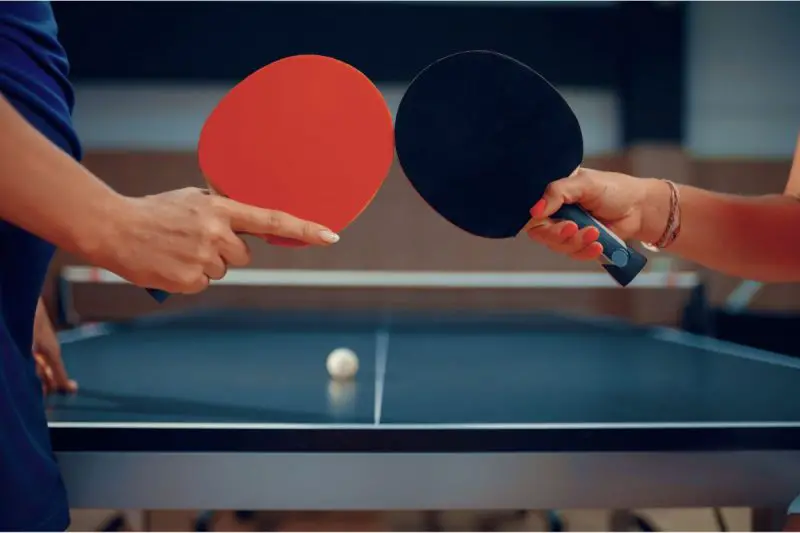Ping pong is an exciting, fast-paced pastime that requires a great deal of coordination, skill, and concentration.
The table must be large enough to accommodate the players, but not so big as to make it difficult for them to move around. So, just what are the dimensions of a ping pong table? We took a closer look.
What Size Is A Ping Pong Table?
The dimensions of the ping pong table are very important because they will determine how many people can play at once.
A standard-size table has a length of 9 feet and a width of 5 feet, and this gives you plenty of room to play.
Smaller-sized tables are also available, and these tend to be around 7 feet by 3.5 feet, as well as larger 10 feet by 6 feet tables, though these are not standard.
Most tables will be around 2.5 feet high to allow everyone to play comfortably.
It is important to note that you will need to allow ample space for your ping pong table – and this does not just mean ensuring that you have space for the table itself.
You will also need to ensure that all of your players can fit around the table for the match, and also offer plenty of space for everyone to move around and play – ping-pong can be a pretty fast-paced game, so make sure that you leave enough clearance for everyone to move quickly and change direction at a moments notice if needed!
The thickness of the top of your ping pong table is also something to be considered, and once again, this will depend largely on the placement of the table.
If you are planning on using the table in a predominantly outdoor capacity, you should opt for a slightly thicker table top, with options between 4 and 10mm thick generally being considered the best options.
This will ensure that your table can withstand the elements, and will be sturdy enough to remain outside in all weather conditions; be that howling gales or pouring rain.
You should also consider opting for a thicker table top if you are planning to install your ping pong table in an area that receives high levels of traffic, and will receive a higher number of players – this includes spaces such as community centers, student unions, schools or other public spaces.
By their very nature, ping pong tables in these areas will receive much higher levels of traffic, and so need a thicker surface to be able to withstand and tolerate this.
Larger table sizes are also recommended here to allow a greater number of players and viewers.
Budget may also be a consideration in the table that you choose; as a rule, larger, sturdier tables tend to come with a higher price tag than non-standard, smaller tables.
They will, however, usually last for longer, and so can act as a smart investment if you are hoping you enjoy your ping-pong table for years to come.
It should also be noted that a larger, heavier table, with a thicker and more sturdy top, will also require extra support to keep them in place and compensate for the heavier top; thicker table tops, in particular, can cause the unit to become slightly “top heavy”, and so should be well secured at the bottom or, if possible, attached directly to the ground for added stability while playing.
As you can see, choosing the best table size for your ping pong games can be a challenge, and will depend largely on a number of factors, including where you are planning to install the table and play, how many people will have access to the table, whether the table is indoors or outdoors, the amount of traffic that is expected, and the budget that you have available.
By taking all of these factors into account, you can rest assured that you make the perfect purchase for your new ping pong table.
What Is Ping Pong?
Ping pong is a game played on a hard surface with a paddle, and involves bouncing a ball back and forth between two opponents.
It’s one of the most popular sports in China, Japan, Korea, Taiwan, Thailand, Vietnam, and a number of other countries – including the United States.

There are different ways to play ping pong, depending on whether you want to play singles or doubles. In singles, only one person plays against another, while in doubles both players take turns hitting the ball.
Essentially, ping pong works by having each player hit the ball with their paddle, which sends it flying across the table towards the opponent.
The overall goal of the game is to hit the ball in such a way that your opponent cannot make contact with it – this earns you a point.
A set of ping pong games are known as a match, and the ultimate winner is usually decided in the best of three out of five games.
Once you have served, you are required to wait for the ball to bounce on your side, and then strike the ball to the other side of the table, or volley if the ball bounces twice. Missing the ball will lose you the point.
The serving player is determined by a number of methods – this could be flip a coin or at random – and will then serve twice before the opponent serves twice.
This continues until you and your opponent both reach “deuce”, or 10 points, at which point each player serves once, rather than twice.
Serving continues to alternate until one of the players reaches a 2-point lead – this wins the game. Players then switch sides for the next game.
Serve the ball in ping pong by holding the paddle vertically above the table and swinging it down onto the ball.
You should aim to hit the ball straight into the air, so that it lands on the opposite side of the table from where you are standing.
If you miss the ball completely, you may still score a point by striking the ball off the edge of the table.
What Is The Best Way To Play Ping Pong?
There are many different ways to play ping pong, depending on how competitive you want to get. Some people prefer to play aggressively, while others enjoy playing defensively.
Here we look at some of the best strategies to use when playing ping pong.
Play Defensively
Playing defensively is often seen as a sign of weakness, but there are times when it is actually the smart way to play.
When you are playing against someone who is very good at ping pong, it is better to play defensively rather than risk losing the game.
Playing defensively is usually done by using a defensive style of play, such as keeping your distance from the opponent, making sure that you do not allow yourself to be hit, and trying to keep the ball away from your opponent.
This type of strategy works well when you are playing against someone whose skills are similar to yours.
However, if you find yourself playing against someone who is significantly stronger than you, then you need to adopt a different approach.
Play Aggressively
Playing aggressively involves taking risks, and sometimes even going all out to beat your opponent. Although this is a risky strategy, it can work well if you know what you are doing.
When playing aggressively, you should try to take advantage of any weaknesses in your opponent’s technique, and make full use of every opportunity to score points.
You should also try to avoid getting into situations where you cannot defend yourself effectively – this can be an issue when you are playing against a very strong opponent.
Final Thoughts
Choosing the perfect ping pong table has a lot of deciding factors included in the decision; you will need to decide where your table will be placed, how often it will be used, and how many people will have access to play.
For high-traffic areas, or tables to be placed outside, opting for a larger size with a thicker table top is advised – and the longevity of these units helps to make up for the slightly higher price tags that tend to come with these tables.
- What Size is Regular Printer Paper? Quick Guide for Paper Dimensions - June 18, 2023
- What Size is My Monitor: A Comprehensive Guide - June 18, 2023
- How Big is Italy Compared to the US? A Concise Comparison - June 16, 2023

